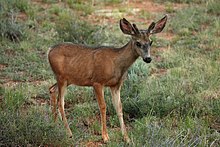Capreolinae
| Capreolinae Temporal range: Late Pliocene to present |
|
|---|---|
 |
|
| Mule deer (Odocoileus hemionus) | |
| Scientific classification | |
| Kingdom: | Animalia |
| Phylum: | Chordata |
| Class: | Mammalia |
| Order: | Artiodactyla |
| Family: | Cervidae |
| Subfamily: |
Capreolinae Brookes, 1828 |
| Genera | |
|
Alces |
|
| Synonyms | |
|
Odocoileinae |
|
Alces
Capreolus
Hydropotes
Rangifer
Hippocamelus
Mazama
Odocoileus
Blastocerus
Pudu
Odocoileinae
The Capreolinae, Odocoileinae, or the New World deer are a subfamily of deer. Alternatively, they are known as the telemetacarpal deer, due to their bone structure being different from the plesiometacarpal deer subfamily Cervinae. The telemetacarpal deer maintain their distal lateral metacarpals, while the plesiometacarpal deer maintain only their proximal lateral metacarpals. The Capreolinae are believed to have originated in the Late Miocene, between 7.7 and 11.5 million years ago, in central Asia.
Although this subfamily is called New World deer in English, it includes reindeer, (Eurasian) elk, and roe deer, all of which live in Eurasia.
The list is based on the studies of Randi, Mucci, Claro-Hergueta, Bonnet and Douzery (2001); Pitraa, Fickela, Meijaard, Groves (2004); Ludt, Schroeder, Rottmann and Kuehn (2004); Hernandez-Fernandez and Vrba (2005); Groves (2006); Ruiz-Garcia, M., Randi, E., Martinez-Aguero, M. and Alvarez D. (2007); Duarte, J.M.B., Gonzalez, S. and Maldonado, J.E. (2008)
...
Wikipedia
